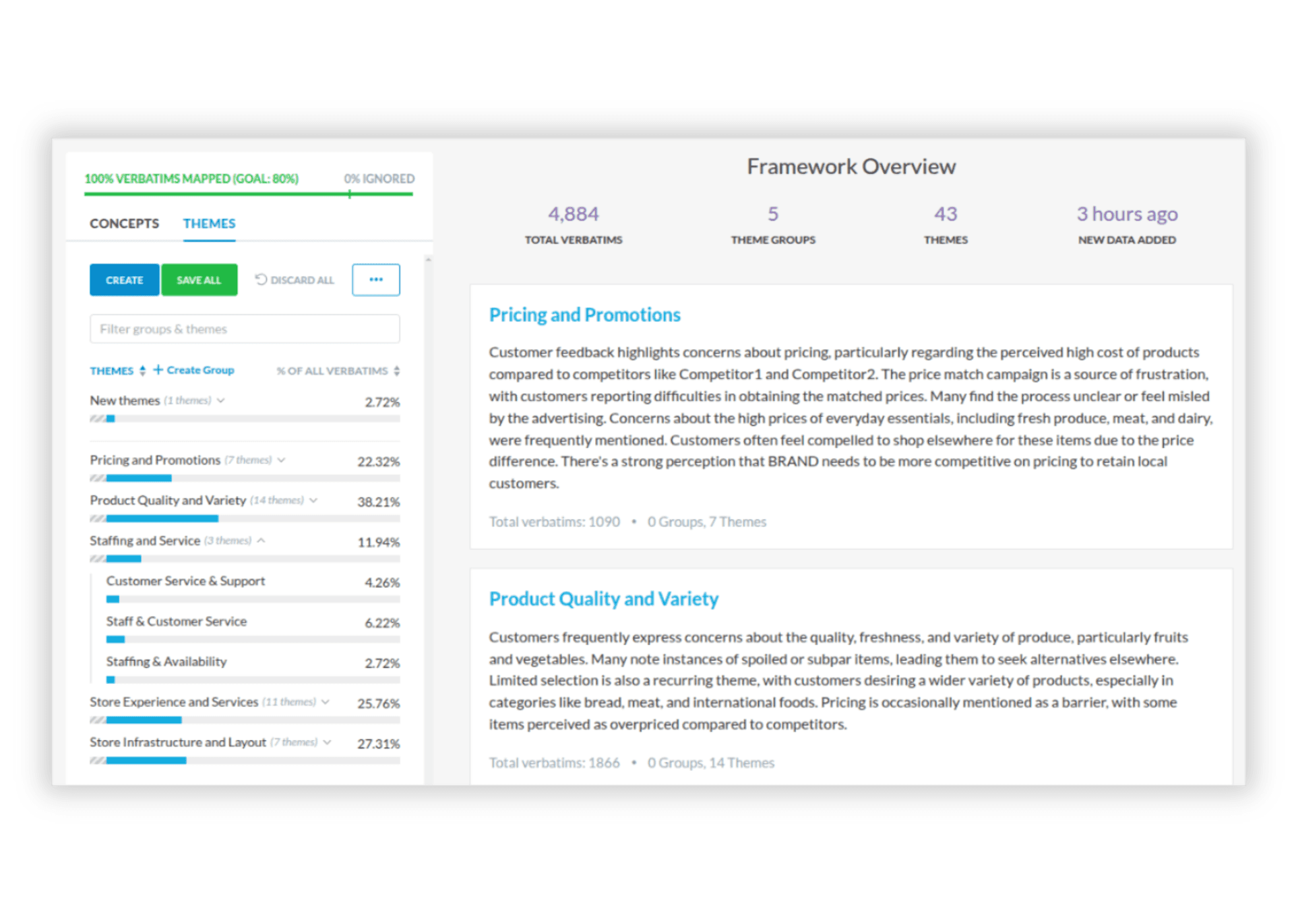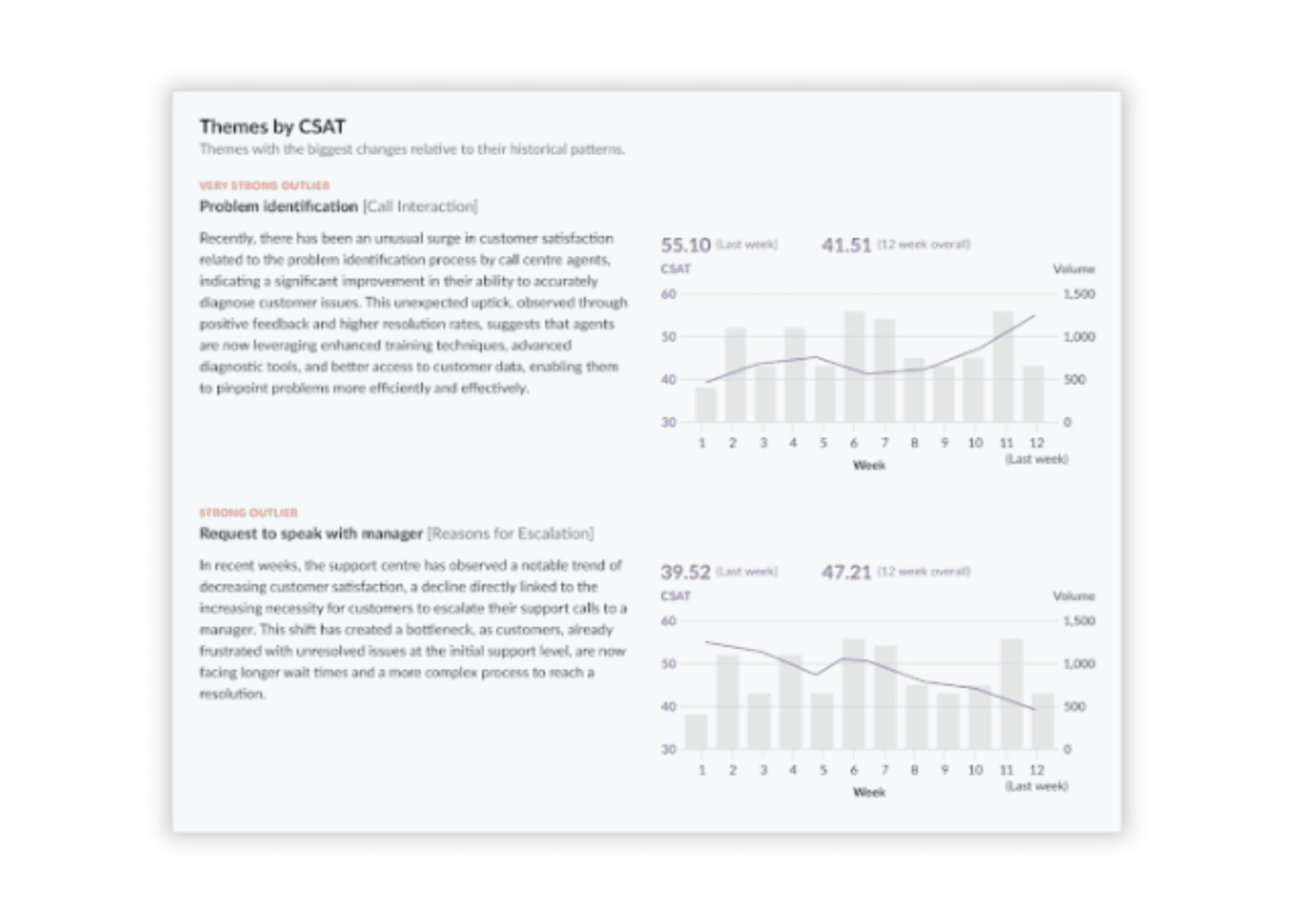Sarah, a support agent, has a customer on hold asking about a billing issue that seems familiar. She searches three different systems while the customer’s frustration builds. Employees spend significant time searching for information instead of focusing on value-added tasks. Meanwhile, across the hall, the CX team is manually sifting through spreadsheets trying to understand why customer satisfaction dipped last quarter.
The answer is buried in thousands of unanalyzed support conversations just like the ones Sarah has on a daily basis.
This disconnect costs more than time. Most companies struggle to store information effectively, leading to inefficiencies. Companies that excel at knowledge management are more likely to be top financial performers, yet most organizations only analyze 1-5% of their customer conversations for actionable insights.
What if every customer interaction could fuel both better service and strategic CX improvements? That’s the power of effective knowledge management for modern CX and Support teams, especially when you store information in a way that makes it easily accessible and usable.

What is Knowledge Management?
Knowledge management isn’t just creating a fancy digital filing cabinet or dumping every process document into a searchable database. At its core, knowledge management is the systematic process of capturing, organizing, sharing, and applying the collective wisdom of your organization to improve decision-making and performance.
For CX and Support teams, this means transforming every customer interaction, every solved problem, and every insight into accessible, actionable intelligence that makes your entire team smarter and more effective.
When your team discovers that customers consistently struggle with a specific feature, that insight should be captured and shared. When an agent develops a particularly effective way to handle billing disputes, that approach should become part of your team’s collective knowledge.
The benefits go far beyond operational efficiency. Effective knowledge management enables your support team to resolve issues faster, reduces training time for new employees, and ensures consistent customer experiences. Institutional knowledge and intellectual capital are key organizational resources that support long-term success. Knowledgeable employees are valuable assets, and recognizing their contributions enhances knowledge sharing and retention.
Managing the company's knowledge and implementing strong information management practices are essential to ensure that knowledge is accessible and usable for both employees and customers.
Why You Need a Knowledge Management Strategy for CX
A robust knowledge management strategy is the backbone of exceptional customer experience. By implementing one, organizations empower both customers and agents with easy access to relevant, up-to-date information, eliminating the frustration of searching through siloed knowledge or outdated resources.
A well-defined knowledge management strategy also fosters a culture of knowledge sharing, where employees are encouraged to contribute their expertise and learn from one another. This collaborative approach not only improves customer satisfaction but also drives continuous improvement and innovation within your organization.
How to Implement Knowledge Management in Your CX Team
You can begin by conducting a comprehensive knowledge audit to map out your organization’s existing knowledge assets, identify knowledge gaps, and clarify your team’s knowledge requirements. This foundational step ensures you understand what information is available, what’s missing, and what your team truly needs to excel.
Assemble a dedicated knowledge management team responsible for overseeing the rollout and ongoing success of your knowledge management system. This team should craft a knowledge management strategy that aligns with your business goals and sets clear metrics for measuring progress and impact.
Select a knowledge base platform or an AI-powered search engine that makes it easy for agents and customers to find answers quickly. The best knowledge management solutions integrate seamlessly with your existing workflows and support continuous updates, ensuring your knowledge base remains current and relevant.
Finally, establish processes for regularly updating and refining your knowledge management system. Encourage feedback from your team, monitor usage patterns, and use analytics to spot areas for improvement. By making knowledge management a living, evolving part of your CX operations, you’ll ensure your team always has the knowledge they need to deliver outstanding service.
7 Knowledge Management Best Practices for CX Teams
In addition to those tips for getting started, the following steps will set you and your team up with strong foundations for effective knowledge management best practices to support your CX and support functions.
1. Turn Every Customer Conversation into Learning Gold
Most organizations treat customer conversations like transactions. Once the call ends, the valuable insights disappear into the digital ether. But forward-thinking CX teams understand that every customer interaction contains intelligence that can improve your entire operation.
Traditional knowledge management focuses on documenting known solutions. Modern knowledge management captures emerging patterns, identifies knowledge gaps, and transforms unstructured conversations into structured insights. This means moving beyond manual note-taking to systematic capturing of knowledge from every customer interaction, ensuring that valuable information is collected, organized, and shared across the organization.
The key is implementing systems that can analyze 100% of your customer interactions. Not just the 1-5% from traditional quality assurance reviews. When you analyze every conversation, you start seeing patterns that individual interactions hide:
Recurring pain points that indicate product or process issues
Language patterns that predict customer satisfaction or churn risk
Knowledge gaps where agents struggle to provide consistent answers
Emerging trends before they become widespread problems
Collaborating with subject matter experts is essential to interpret and validate the insights derived from customer conversations, ensuring that both technical and non-technical knowledge is accurately captured and leveraged. This approach transforms your support center from a cost center into a strategic intelligence hub.
Platforms like Kapiche enable this transformation by automatically analyzing conversations across all channels (calls, chats, emails, and surveys) to surface themes, sentiment, and actionable insights that traditional methods miss. These platforms leverage machine learning to process large volumes of conversation data, enhancing the accuracy and relevance of the insights provided.

2. Create a Living, Breathing Knowledge Base (Not a Digital Graveyard)
We’ve all encountered documentation that feels like a graveyard. Databases full of outdated information that nobody bothers to update.
Static knowledge management is often worse than no knowledge management, because it actively misleads your team and frustrates customers. Failing to properly store information can result in inaccessible or irrelevant knowledge, making it difficult for both agents and customers to find what they need.
Effective knowledge management for CX teams requires dynamic systems that evolve with your customers’ changing needs and your organization’s growing understanding. This means building feedback loops that continuously improve your knowledge resources based on real customer interactions.
Here’s how to keep your knowledge base alive and relevant:
Monitor conversation patterns to identify when existing knowledge becomes outdated
Track which articles agents access most frequently during customer interactions
Identify knowledge gaps where agents consistently struggle to find answers
Update content based on seasonal trends and product changes
Retire outdated information that no longer serves your team or customers
Ensure the knowledge base delivers relevant content to both agents and customers, so they can quickly access the most useful and personalized information
The most effective knowledge bases become self-improving systems. When your conversation analysis reveals that customers are asking new types of questions about a product feature, that intelligence should trigger knowledge base updates. When agents repeatedly search for information that doesn’t exist, that gap becomes a priority for content creation.
Modern platforms enable a continuous improvement cycle by connecting conversation insights directly to knowledge management workflows. So instead of waiting for quarterly reviews or annual audits, your knowledge base evolves in real-time based on actual customer needs and agent experiences. A well-maintained knowledge base empowers customers to self serve, allowing them to independently find answers without needing agent assistance.

3. Make Knowledge Sharing Feel Like Winning, Not Working
The biggest barrier to effective knowledge management is human nature. People tend to hoard knowledge because they believe it provides job security, or because sharing feels like extra work without clear benefits.
To maximize the benefit from your efforts, it is crucial to encourage many employees to share knowledge across teams and departments.
Successful knowledge management practices create cultures where sharing knowledge feels rewarding, not burdensome. The goal is to build a knowledge-sharing culture that fosters collaboration, information exchange, and positive behavior change among employees. This requires designing systems and incentives that make knowledge sharing feel natural and valuable.
Start by making knowledge contribution as easy as possible:
Integrate sharing into existing workflows rather than creating separate processes
Use conversation analysis to automatically identify when agents solve novel problems
Capture knowledge at the moment of creation rather than asking for documentation later
Recognize and celebrate knowledge contributors publicly and meaningfully
Provide tools and incentives that make it simple for employees to share knowledge with their peers
Advanced conversation intelligence platforms can automatically identify these knowledge-sharing opportunities by analyzing conversation outcomes, customer satisfaction patterns, and resolution effectiveness. This transforms knowledge sharing from a manual burden into an automated recognition system that highlights what’s working and what needs improvement.

4. Bridge the Gap Between What Customers Ask and What Agents Know
One of the most persistent challenges in support teams is the mismatch between customer questions and agent knowledge. Customers evolve their language, discover new use cases, and encounter novel problems faster than training programs can adapt. Ensuring everyone is on the same page is crucial for providing consistent customer experiences.
Traditional training approaches rely on periodic reviews and manager observations to identify knowledge gaps. But this reactive approach means agents struggle with the same issues repeatedly while customers receive inconsistent experiences.
Smart knowledge management practices use conversation data to identify training opportunities in real-time:
Topic analysis reveals which subjects generate the most confusion or longest resolution times
Language pattern recognition identifies when customers use terminology that agents don’t understand
Outcome correlation shows which knowledge gaps most directly impact customer satisfaction
Performance benchmarking highlights agents who excel at specific types of interactions
Sharing knowledge with other teams helps break down silos and improve collaboration, ensuring that insights and solutions are accessible across the organization.
Platforms like Kapiche make this possible by analyzing conversation themes, agent performance patterns, and customer satisfaction outcomes to identify precise training opportunities. When the data shows that agents struggle with billing disputes on Fridays (perhaps because of end-of-month processing complexities), that becomes a specific, actionable training target.

5. Turn Silos into Superhighways
Traditional knowledge management treats departments like islands. Support has their knowledge base, Product has their documentation, Marketing has their resources, and CX has their insights. This siloed approach wastes the incredible intelligence that customer conversations generate for the entire organization.
Modern knowledge management practices break down these barriers by creating shared intelligence that benefits every department. Customer conversations contain insights that can improve product development, inform marketing messaging, guide CX strategy, and optimize support operations. Optimizing communication channels ensures that knowledge flows freely and reaches the right people at the right time.
Here’s how cross-functional knowledge sharing creates organizational value:
Product teams learn about feature requests and usability issues directly from customer conversations
Marketing teams discover the language customers actually use to describe problems and benefits
CX teams identify journey friction points that appear in support interactions
Leadership teams gain strategic insights from customer conversation trends
Leveraging community discussions helps surface and share valuable insights across the organization
The key is implementing systems that automatically route relevant insights to the right teams. Integrating knowledge across different platforms enhances accessibility and ensures no valuable information is lost. Using a centralized KM system supports knowledge sharing and collaboration, making it easier for teams to access, organize, and act on insights.
6. Predict What Customers Will Need Before They Ask
The most sophisticated knowledge management practices don’t just respond to current needs, they anticipate future requirements. By analyzing conversation patterns, seasonal trends, and emerging themes, you can prepare your team for challenges before they become widespread problems. Aligning predictive practices with your organization's KM strategy ensures that these efforts are integrated, targeted, and effective.
Predictive knowledge management enables several strategic advantages:
Proactive content creation for issues that are starting to emerge
Seasonal preparation for predictable volume spikes or question types
Product launch support based on patterns from similar releases
Trend identification that informs broader CX strategy
The strategic value of doing this extends past operational efficiency. Successful organizations use KM strategies to anticipate and address emerging customer needs, ensuring that knowledge sharing and system efficiency are continuously improved. Predictive customer intelligence can inform product roadmaps, guide CX investments, and help leadership make data-driven decisions about resource allocation and strategic priorities.
To implement predictive knowledge management effectively, a strong KM initiative is required—one that is supported by leadership, a dedicated team, and advanced tools. Investing in predictive knowledge management makes sense because it leads to better organizational efficiency and an improved customer experience.
7. Measure What Matters: Knowledge Impact on Business Outcomes
The most sophisticated knowledge management systems mean nothing if they don’t drive measurable business results. Measuring the effectiveness of your knowledge management program is essential to ensure it delivers real value. Effective knowledge management practices require clear metrics that connect knowledge activities to customer satisfaction, operational efficiency, and business outcomes.
Traditional knowledge management metrics focus on activity rather than impact. Metrics like the number of articles created, search queries performed, or knowledge base page views tell you about usage, but not about value.
Following best practice, organizations should use metrics that connect knowledge management activities to business outcomes, not just usage statistics.
First-contact resolution rates improve when agents have better access to relevant knowledge
Customer satisfaction scores increase when knowledge enables more effective problem-solving
Agent productivity metrics show efficiency gains from improved knowledge access
Training time reduction demonstrates knowledge management’s impact on onboarding
Cross-sell and upsell success can improve when agents have better product knowledge







